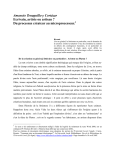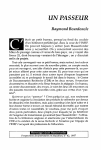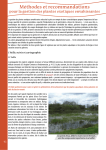Download ordredesassocies
Transcript
C O L L E G E O F L ’ O R D R E D E S F E L L O W S A S S O C I E S C O L L E G E O F L ’ O R D R E D E S F E L L O W S A S S O C I E S Investiture Ceremony at Congress 2013 Friday, July 12th, 2013 Regina, Saskatchewan Fellows at Congress 2012 - Halifax, Nova Scotia C O L L E G E L ’ O R D R E O F F E L L O W S D E S A S S O C I E S Investiture Ceremony at Congress 2013 Friday, July 12th, 2013 Induction of 2013 Fellows by: Wendy Graham, AAPQ, FCSLA, Vice Chair, College of Fellows & Claude Potvin, President, AAPQ, CSLA T h e F e l low s o f 2 0 1 3 The CSLA/AAPC College of Fellows A Brief History Election to fellowship first began in 1964 with the designation of four honourees. In the subsequent 15 years over 30 members had been elected, eliciting demand for a more formalized structure and process to the promotion of fellowship. It was at CSLA/AAPC Congress ‘79 in Charlottetown that the College of Fellows was formally established, and the Rules for the Conduct of Operations were adopted. The rules structured and outlined the operation of the College, and developed guidelines for the advancement of members to Fellowship. The Annual Meeting of the College is held in conjunction with the CSLA/ AAPC Congress every year, and for the past several AGM’s nearly two dozen Fellows have been in attendance. An Executive Committee for the College that includes the Chair, Vice Chair, Secretary-Treasurer, the President of the Landscape Architecture Canada Foundation (LACF) and the President of the CLSA/AAPC (ex-officio member), are responsible for the conduct of affairs within the College. There is particular emphasis within the Rules for the Conduct of Operations given to the manner in which new Fellows are admitted to the College, as well as the perceived role the College holds within the larger scope and activities of the profession and it’s societies. In accordance with the Rules for the Conduct of Operations, nominations for Fellowship may be presented to the College by the component organizations and/or the Board of Governors of the CSLA/APPC. The final selection is made by a jury of Fellows, comprised of representatives from Canada’s five regions (B.C., Prairies, Ontario, Quebec, Maritimes), who serve on the jury for overlapping three-year terms. The FellowsElect are then ceremoniously inducted into the College during the banquet or other special event of the next CSLA/AAPC Congress. T h e F e l low s o f 2 0 1 3 since 1987, as well as the LACF. Since the Campaign of Fellows commenced in 1988, over $480,000 have been donated by Fellows to the Foundation. These funds are used to promote the ideals of the profession of landscape architecture through research and scholarship grants, firmly establishing the Foundation as a significant force in the future of the landscape architectural profession in Canada. In recent years a special effort has been made to establish a profile record on each Fellow, in order to have such information available for present and future generations of landscape architects. To-date, these records are on file for 87% of the Fellows. Since the inception of CSLA/AAPC, a total of 186 Fellows have been elected, 160 of whom are still active members of the college. Criteria for Election to CSLA/AAPC Fellowship Election to Fellow is the highest honour the CSLA/AAPC bestows on its members. Fellowship is the recognition of members who have made outstanding contributions to the profession over an extended period of time in one or more of the following categories: Executed Works of Landscape Architecture Administrative Professional Work in Public Agencies Professional University Instruction Professional Writing Service to the Community or the Public on behalf of the Society Direct Service to the Society Other activities of the College and its members involves assisting in the operation of the Accreditation Council, which administers the accreditation of Canadian schools/departments of landscape architecture Other requirements for election are a minimum of twelve (12) years uninterrupted membership in the Society, strictly enforced confidentiality of nomination and a confirmative 75% majority vote by the Jury of Fellows. Outstanding contributions are generally considered to be contributions, which are above and beyond those provided by a member of the profession. Particular attention is paid to those practitioners who have made nationally or internationally recognized contributions. 2 3 T h e F e l low s o f 2 0 1 3 Histoire de l’Ordre des associés de l’AAPC/CSLA L’élection d’associés a débuté en 1964 avec la nomination de quatre membres. Au cours des 15 années suivantes, 30 membres ont reçu cette distinction, ce qui a nécessité la mise en place d’une structure et d’un processus plus formel pour la promotion au rang d’associé. C’est à l’occasion du congrès de l’AAPC/CSLA de 1979 à Charlottetown que l’Ordre des associés a vu le jour et que ses règles de conduite et de fonctionnement ont été adoptées. Ces règles régissent l’Ordre et ses activités, en plus d’inspirer les lignes directrices pour la promotion des membres au rang d’associé. L’assemblée générale de l’Ordre a lieu en même temps que le congrès annuel de l’AAPC/CSLA. Au cours des dernières années, une vingtaine d’associés y ont participé en moyenne. Le Comité exécutif de l’Ordre, composé d’un président, d’un vice-président, d’un secrétaire-trésorier, du président de la Fondation d’architecture de paysage du Canada (FAPC) ainsi que du président de l’AAPC/CSLA (membre d’office), veille à la bonne marche de l’Ordre. Par ailleurs, les règles de conduite opérationnelles accordent une grande importance à la façon d’admettre les nouveaux associés dans l’Ordre, et à la façon dont est perçu l’Ordre dans le cadre des activités et de la portée de la profession et de ses constituantes. Conformément aux règles de conduite opérationnelles, les candidatures au titre d’associé sont proposées à l’Ordre par les associations constituantes et par le conseil d’administration de l’AAPC/CLSA. La sélection est effectuée par un comité de représentants des cinq grandes régions du Canada (C.-B., Prairies, Ontario, Québec et provinces de l’Atlantique) dont les mandats de trois ans se chevauchent. Par la suite, les personnes promues au rang d’associé sont accueillies dans l’Ordre lors d’une cérémonie officielle tenue à l’occasion d’un banquet ou d’un événement spécial lors du congrès de l’AAPC/CSLA. Entre autres activités, l’Ordre et ses membres aident au bon fonctionnement du Conseil d’agrément, qui s’occupe depuis 1987 de l’agrément des écoles et des facultés canadiennes d’architecture 4 T h e F e l low s o f 2 0 1 3 de paysage, et de la FAPC. Depuis l’avènement de la « Campagne des associés », en 1988, l’Ordre a versé plus de 480 000 $ en dons à la Fondation. Ces sommes servent à promouvoir les idéaux de la profession d’architecte paysagiste par la recherche et des bourses d’études, établissant du coup le leadership de la Fondation pour l’avenir de la profession au Canada. Des efforts spéciaux ont été faits au cours des dernières années pour dresser le profil personnel de chaque associé, à l’intention des générations actuelles et futures d’architectes paysagistes. Nous avons actuellement les profils à jour de 87 % des associés. Depuis la création de l’AAPC/CSLA, 186 associés ont été élus, dont 160 sont toujours membres actifs de l’Ordre. Critères d’admission de l’Ordre des associés de l’AAPC/ CSLA L’élection au rang d’associé est la plus grande distinction que l’AAPC/ CSLA accorde à ses membres. C’est la reconnaissance de leur apport exceptionnel à la profession pendant une période prolongée dans l’une ou plusieurs des catégories d’activités suivantes : Travaux exécutés dans le secteur de l’architecture de paysage Travail administratif professionnel auprès d’organismes publics Enseignement universitaire professionnel Rédaction professionnelle Service à la communauté ou au grand public, pour le compte de l’Association Service de première ligne à l’Association Pour être admis au sein de l’Ordre, les candidats doivent aussi avoir été membres de l’Association pendant au moins douze (12) ans sans interruption, avoir fait l’objet d’une nomination strictement confidentielle et avoir obtenu la faveur de 75 % du Comité de sélection. Règle générale, un apport exceptionnel signifie une contribution qui va au-delà de ce qui est habituellement attendu d’un membre de la profession. Sont visés particulièrement les professionnels qui se sont distingués sur la scène nationale et internationale 5 T h e F e l low s o f 2 0 1 3 T h e F e l low s o f 2 0 1 3 College of Fellows Chairs Dual Fellowship in CSLA and ASLA 1979-84 1984-86 1986-87 1987-89 1989-90 1990-92 1992-94 1994-96 1996-98 1998-00 2000-02 2002-04 2004-06 2006-08 2008-10 2010-12 2012-13 Since 1975, fourteen Canadian Landscape Architects had the rare and exceptional honour of being elected to both the CSLA/AAPC College of Fellows and the ASLA Council of Fellows. These are recorded as follows: William E. Coates, OALA E. J. (Jack) Walker, SALA James R. Taylor, OALA Douglas D. Paterson, BCSLA Jack D. Milliken, OALA Leonard L. Novak, AALA Ronald F. Williams, AAPQ Peter G. Klynstra, APALA Alexander Budrevics, OALA Don Vaughan, BCSLA Charles H. Thomsen, MALA John B. MacLeod, AAPQ Carolyn S. Woodland, OALA Ronald J. Middleton, AALA James Melvin, OALA Peter Kreuk, BCSLA Ted Baker, OALA C.o.F. Secretary-Treasurers 1979-89 1989-91 1992-08 2008-pr Owen R. Scott, OALA M. Garry Hilderman, MALA Gunter A. Schoch, MALA Jane Durante, BCSLA 1. Alexander Budrevics, OALA 2. Louis Perron, AAPQ 3. Gunter A. Schoch, MALA 4. Cameron R. J. Man, BCSLA 5. Walter H. Kehm, OALA 6. Peter Jacobs, AAPQ 7. Cornelia Oberlander, BCSLA 8. James Stansbury, OALA 9. Ann Milovsoroff, OALA 10. James R. Taylor, OALA 11. Cecelia Paine, OALA 12. Don Vaughan, BCSLA 13. George Dark, OALA 14. Greg Smallenberg, BCSLA Jury of Fellows Foremen 1987-91 1991-93 1993-97 1997-00 2000-02 2002-11 2012-pr Cornelia Oberlander, BCSLA Charles H. Thomsen, MALA M. Garry Hilderman, MALA Vincent Asselin, AAPQ Jane Durante, BCSLA Cary C. Vollick, APALA Margot Long, BCSLA 6 CSLA Fellow ASLA 1975 1974 1985 1982 1986 1981 1981 1982 2001 1980 1993 1983 2004 2004 1975 1978 1973 1985 1986 1990 1992 1993 1999 2004 2006 2008 2010 2010 Fellow 7 T h e F e l low s o f 2 0 1 3 T h e F e l low s o f 2 0 1 3 CSLA/AAPC Fellows 1964 * Otis Bishopric * Gordon Culham * Howard B. Dunington-Grubb Maurice H. Howitt * Edward I. Wood 1966 * Frances V. Blue 1967 * Robert G. Calvert 1972 E. J. (Jack) Walker 1973 * Victor Chanasyk * J. Austin Floyd Warner S. Goshorn Donald W. Graham Macklin L. Hancock * Douglas W. Harper * John W. Neill Edwin J. Skapsts Emiel Van der Meulen 1974 * Ibsen E. Brodersen Bradley R. Johnson Clive L. Justice Andre E. Lafontaine * Louis Perron Donald W. Pettit * Janina Stensson 1975 Alexander Budrevics * George Tanaka 1976 * William E. Coates Raymond Gascon Alexander E. Rattray 1977 Owen R. Scott 1978 * Philip W. Tattersfield 1979 * Raoul Robillard 1980 * Maurice Hamel Jack D. Milliken Reinhart L. Petersmann James R. Taylor Nick Van Vliet 1981 Benoit J. Begin * Michael Hough Peter Jacobs Cornelia Oberlander Marius Ois 1982 Heinz H. G. Berger M. Garry Hilderman Cameron R. J. Man * Andre Sauve James Stansbury 1986 Walter H. Kehm Leonard L. Novak Friedrich Oehmichen 1987 * Peter G. Klynstra Ronald F. Williams 1988 Edward H. Fife Charles H. Thomsen 1989 Andre Chartrand 1990 Douglas B. Clark Jane L. Durante Kenneth J. Hoyle Moura Quayle 1991 Irene Cinq-Mars Glenn D. Harrington Lawrence R. Paterson 1983 Edward P. Holubowich Frank D. Milius Daniele Routaboule Don Vaughan 1992 Edwin S. (Ted) Baker Donald B. Barron John D. Consolati Marie Kipen 1984 * Ulric Couture * Arthur R. Cowie * Georges Daudelin Dieter Gruenwoldt R. Hugh Knowles Douglas D. Paterson 1993 Vincent Asselin Cecelia Paine Carolyn S. Woodland 1985 John L. Lantzius Estyl J. Mooney Gunter A. Schoch 8 1994 Carole Beauregard Roderick B. MacDonald John B. MacLeod Steven Moorhead 1995 Robert N. Allsopp Alfred Simon 1997 Garry Carson E. B. (Ted) McLachlan James H. Melvin Chantal Prud’homme Jean-Francois Rolland Cary C. Vollick 1999 Catherine Berris John (Jack) P. Copeland Donald K. Hester Ronald J. Middleton Jeffrey J. Philips 2000 David Anselmi Robert W. Crosby Robert A. Gibbs Gerald A. G. Lajeunesse Faye E. Langmaid Eha Mai Naylor Robert M. Wright 2001 Louis Beaupre Patrick Bollenberghe Arnis Budrevics Vincent Dumais Ann Milovsoroff J. David Mitchell Richard Moore Christopher Phillips Janet L. Rosenberg Thomas W. Sparling David M. Wagner 2003 Alan S. Duncan Richard Gaudreau John B. Hillier Donna Hinde Peter G. Kreuk Domenic Lunardo Patrick F. Mooney David J. Reid Marie-Claude Robert * Andre A.Schwabenbauer Richard A. Strong 2004 Ian Dance George F. Dark Gerry Eckford Michèle Gauthier David Leinster Anne-Marie Parent Campbell Patterson Ronald Rule Greg Smallenberg Barry A.Yanchyshyn 2005 Alain Baillargeon Garth Balls Rudolf Hofer Jean-Marc Latreille Margot Long D. James Paterson James T. Sackville 2006 Brian Baker Adrienne L. Brown Patrick R. Butler Cynthia D. Cohlmeyer Bruce E. Cudmore Charles Ken Dockham Roger Green Patrick Li Serge Poitras Beverly A. Sandalack Daniel Trottier 2008 Claude Cormier James A. Dobbin Chantal Gagnon Daniel K. Glen Sara-Jane Gruetzner Randall F. Sharp John W. Zuck 9 2009 Pierre Bouchard Colleen Mercer Clarke Heather Cram Wendy Graham Achim A. Jankowski * John C. Laird Joann Latremouille Jim Vafiades Laurie Lamb Wagner 2010 Malaka Ackaoui David Brown Doug Carlyle Daniel Chartier Victor Kallos Cathy Sears George Stockton 2011 Penny Dunford Cynthia L. Girling Karen Le Gresley Harme Myke Hodgins Rob Le Blanc Liane McKenna Wendy Shearer Ian Wasson 2012 Doug Backhouse Lise Cormier Carol Craig Linda Dicaire Jeff Frank Linda Irvine Don Naylor 2013 Peter Bigelow Neil Dawe Jean Landry Edward (Ted) C. Muller James (Jim) C. Thomas (* Deceased) T h e F e l low s o f 2 0 1 3 Peter Bigelow is a graduate of Acadia University with a degree in biology (1983) and the University of Guelph with a BLA (Hons) in 1987. He became a full member of APALA and the CSLA in 1989. He practiced with John Pazahanick, Peter Klynstra and Gordon Radcliffe before joining the City of Halifax in 1989 as the City’s first landscape architect. Since that time Peter has played a large part in taking the role of municipal landscape architecture from planting bed design to Regional Planning and everywhere in between. His public practice has included park and open spaces, municipal policy planning, infrastructure planning and emergency management. Peter believes in teamwork. Throughout his public career Peter has sought to showcase the talent, leadership and broad range thinking of landscape architects through hiring of staff and consultants and placing them in roles of leadership where they are able to demonstrate their approach and skills alongside the traditional positions of municipal engineers and planners. This was with the idea that landscape architectural practice is so based on interdisciplinary problem solving that they were also ideally suited to lead complex, multi-disciplinary, municipal initiatives.The most extreme example of this is Peter’s leadership role in co-ordinating multi-agency emergency response to local disasters including the Swiss Air Crash, Hurricane Juan, White Juan Blizzard, and Operation Sleepover in response to the September 11 attacks on the United States, all which earned the Municipality and Peter recognition for excellence in Emergency Management. Currently Peter is Manager of Public Lands Portfolio Planning where he is engaged in the use of public lands to provide services, shape the region and create an attractive advantage to ensure that the Halifax Regional Municipality continues to strengthen socially, economically and environmentally. Peter was Vice President and then President of the Atlantic Provinces Association of Landscape Architects between 1999 and 2003. Titulaire d’un diplôme en biologie de l’Université Acadia (1983) et d’un baccalauréat spécialisé en architecture de paysage de l’Université de Guelph (1987), Peter Bigelow est devenu membre à part entière de l’Atlantic Provinces Association of Landscape Architects (APALA) et de l’Association des architectes paysagistes du Canada (AAPC) en 1989. Au cours de cette même année, il a travaillé avec John Pazahanick, Peter Klynstra et Gordon Radcliffe avant d’entrer au service de la Ville d’Halifax comme premier architecte paysagiste. M. Bigelow a transformé l’architecture de paysage municipale, qui ne tenait qu’à la conception de plates bandes avant son arrivée, pour faire place à la planification régionale et bien plus. Dans le domaine public, il s’est occupé des parcs et des espaces verts, de la planification des politiques municipales, de l’aménagement des infrastructures et de la gestion des urgences. M. Bigelow accorde une grande importance au travail d’équipe. Depuis ses débuts dans le secteur public, il cherche à promouvoir le talent des architectes paysagistes, leur leadership et leur capacité de planification en les embauchant à titre d’employés ou de conseillers, et en leur attribuant des fonctions qui leur permettent d’influer sur l’approche traditionnelle des ingénieurs et des planificateurs municipaux à l’aide de leurs points de vue et de leurs compétences. Les architectes sont passés maîtres dans la résolution de problèmes interdisciplinaires dans le cadre de leurs fonctions, ce qui leur permet de bien diriger les initiatives municipales complexes et multidisciplinaires. Le rôle qu’à joué M. Bigelow dans la coordination des interventions d’urgence multiservices à la suite des sinistres qui ont eu lieu dans la région, comme l’écrasement d’un avion de Swissair, l’ouragan Juan, le blizzard White Juan et l’opération Sleepover après les attentats du 11 septembre aux ÉtatsUnis, fait état de cette capacité. D’ailleurs, la municipalité et M. Bigelow ont été reconnus pour leur excellence dans la gestion des urgences. T h e F e l low s o f 2 0 1 3 Mr. Neil Dawe began his professional career with a Diploma in Forest Resource Technology in 1976. From there, he obtained a Bachelor of Design in Environmental Planning and continued on to graduate with a Master of Landscape Architecture from the University of Guelph in 1993. He also has a Master Certificate in Project Management from York University. Neil became a member of the CSLA in 1995 and shortly thereafter sat on the Board of Directors. He is a Past-President of the CSLA and a Rotary Paul Harris Fellow. He is a member of the American Society of Landscape Architects (ASLA) and helped form the Newfoundland and Labrador Association of Landscape Architects (NLALA). Neil has held roles such as Acting Superintendent for Castle Hill National Park; Park Warden for Gros Morne National Park; Assistant Superintendent of Parks and Recreation with the City of St. John’s; Executive Officer of the Grand Concourse Authority; and Editor-in-Chief of the Grand Concourse Walkway Maintenance Manual, which earned a National Honour Award from the ASLA. Peter Bigelow Neil Dawe Category Administrative Professional Work in Public Agencies Category Executed Works Direct Service to the Society Catégorie Travail professionnel administratif dans des agences publiques Catégorie Travaux exécutés Service de première ligne à l’Association Neil is an entrepreneur and has been the owner and President of Tract Consulting Inc. since 1998, a company focused on providing professional planning and landscape architectural services. He is also the Managing Partner of VIRDIS Place Branding and Design, a fullservice marketing and placebranding company. Both of Neil’s companies have won awards for excellence on a national scale. Neil has been a mentor to over 40 young landscape architects throughout his career and is a leader in sustainable community planning and design Titulaire d’un diplôme en technologie des ressources forestières, Neil Dawe a fait ses débuts professionnels en 1976. Il a ensuite obtenu un baccalauréat en design et en planification écologique, puis une maîtrise en architecture de paysage de l’Université de Guelph, en 1993. Il détient par ailleurs un certificat en gestion de projet de l’Université York. M. Dawe est devenu membre de l’AAPC en 1995 et a siégé à son conseil d’administration peu de temps après. Il est président sortant de l’AAPC et détient le titre honoraire Paul Harris Fellow de la Fondation Rotary. Il est membre de l’American Society of Landscape Architects (ASLA) et a contribué à la formation de la Newfoundland and Labrador Association of Landscape Architects (NLALA). M. Dawe a occupé différents postes : surintendant intérimaire pour le lieu historique national du Canada de Castle Hill; gardien au parc national du Canada du Gros-Morne; surintendant adjoint du service des parcs et des loisirs pour la cité de St. John’s; cadre dirigeant de la Grand Concourse Authority; ainsi que rédacteur en chef du manuel d’entretien des voies piétonnières du Grand Concourse, qui a reçu un prix d’honneur national de l’ASLA. M. Dawe est un entrepreneur : depuis 1998, il est propriétaire et président de Tract Consulting Inc., une entreprise qui offre des services de planification et d’architecture de paysage. Il est également l’associé directeur général de VIRDIS Place Branding and Design, une entreprise offrant une gamme complète de services de marketing et de valorisation des lieux. Les deux entreprises de M. Dawe ont reçu des prix d’excellence à l’échelle nationale. M. Dawe a été le mentor d’une quarantaine de jeunes architectes paysagistes au cours de sa carrière. Il est sans contredit un chef de file en design et en planification communautaire durable. À l’heure actuelle, M. Bigelow est gestionnaire de la planification des terres publiques, offre des services publics et aménage les terres de façon à rendre la région de Halifax plus attrayante et forte sur les plans social, économique et environnemental. De 1999 à 2003, M. Bigelow a occupé le poste de vice-président, puis de président de l’APALA. 10 11 T h e F e l low s o f 2 0 1 3 T h e F e l low s o f 2 0 1 3 Jean Landry a complété un baccalauréat en architecture de paysage à l’Université de Montréal en 1980, une maîtrise en administration des affaires (MBA) à l’Université de Athabasca en 2004 et un programme court de deuxième cycle de l’Université du Québec en gestion du développement économique urbain en 2012. Il ne cesse de vouloir s’améliorer. Edward’s (or Ted’s) academic credentials include undergraduate studies in architecture and a Bachelor of Landscape Architecture degree from the University of Guelph in 1975. He was accepted as a member of the AALA in 1977 and has served as a Director and on numerous committees since then and as an AALA representative for the NAIT Advisory Board and the Edmonton Design Committee. Ted has served as a Past President of the Canadian Birkebeiner Society and is currently a member of the Edmonton Urban Design Awards Committee. Il débuta sa carrière municipale de plus de 30 années au Jardin botanique de Montréal en concevant le Jardin du Québec pour les Floralies Internationales de 1980. Il coordonna la production d’une compilation de végétaux ligneux ornementaux adaptés aux conditions climatiques urbaines canadiennes (1978-81) et veilla à la mise en place d’un réseau d’essais pour plantes ornementales de 1981 à 1989. De 1982 à 1993, il occupa divers postes administratifs et professionnels qui soutinrent la place de l’architectes paysagistes dans les programmes de redéveloppement urbains et la planification des réseaux bleu et vert (1994 à 2004). Un des résultats obtenus fut la production d’un cadre de référence unique sur les espaces publics (1994). Tout au long de sa carrière, son approche fut caractérisée par la complexité des dossiers traités et une implication des parties prenantes mettant en lumière un esprit de synthèse doublé d’une pensée stratégique ancrée dans la réalité. Membre intéressé de l’AAPQ et de l’AAPC depuis 1982, il participe activement au développement de deux des plans stratégique de l’AAPQ (2003 et 2013), il collabore depuis plus de trois années à la promotion de l’architecture de paysage par sa participation au magazine Landscape/Paysage et il oeuvre actuellement au sein du groupe de travail visant la préparation d’une Charte de paysage Canadienne. Depuis sa retraite en 2010, il divise son travail entre la photographie de paysage et il pratique en tant que consultant spécialisé en concertation participative visant à résoudre des problématiques urbaines et à doter les communautés d’un meilleur cadre de vie. Jean Landry completed a B.A. in Landscape Architecture at the University of Montréal in 1980, a Master’s in Business Administration (MBA) at Athabasca University in 2004 and a short master’s program at the Université du Québec in urban economic development management in 2012. He is constantly seeking to advance his knowledge and skills. He began his municipal career over 30 years ago at the Montréal Botanical Garden by designing the Québec Garden for the 1980 Floralies Internationales. He coordinated production of an ornamental woody vegetation collection adapted to Canadian urban climatic conditions (197881) and, in 1981 to 1989, supervised implementation of a test network for ornamental plants. Following graduation, Ted travelled west and worked first with Lombard North Group and then EDA Collaborative. Since 1990, he has managed EDA’s Edmonton office and as a principal has provided planning and design leadership on a wide range of environmental, parks, open space and cultural planning projects, urban design studies and community engagement. This portfolio includes extensive experience in western and northern Canada, Ontario and internationally in China. He has been recognized with several planning and design awards and has been invited to lecture at both the University level and professional conferences. Jean Landry Edward (Ted) C. Muller Catégorie Travail professionnel administratif dans des agences publiques Service direct à la Société Category Executed Works Direct Service to the Society Category Administrative Professional Work in Public Agencies Direct Service to the Society Catégorie Travaux exécutés Service de première ligne à l’Association Ted’s passion for landscape architecture has been expressed both at a regional and site specific scale. Since 1998, he has helped guide a new vision for the North Saskatchewan River Valley in the Edmonton Capital Region through his ongoing work with the River Valley Alliance. He has also developed a unique depth of experience in trail planning and design working in both backcountry and urban conditions. Edward (Ted) C. Muller a fait des études de premier cycle en architecture et a obtenu un baccalauréat en architecture de paysage de l’Université de Guelph en 1975. Il est devenu membre de l’Alberta Association of Landscape Architects (AALA) en 1977. Il a depuis occupé un poste de directeur et siégé à de nombreux comités. Il a également été représentant de l’AALA au comité consultatif du Northern Alberta Institute of Technology et au Edmonton Design Committee. M. Muller est président sortant de la Canadian Birkebeiner Society, et siège à l’heure actuelle à l’Edmonton Urban Design Awards Committee. Après l’obtention de son diplôme, M. Muller a mis le cap vers l’Ouest et a d’abord travaillé pour Lombard North Group, puis EDA Collaborative. Depuis 1990, il dirige le bureau d’EDA à Edmonton où il est responsable, à titre d’architecte paysagiste principal, de l’urbanisme et du design de nombreux projets : environnement, parcs, espaces verts, planification culturelle, études en design urbain et engagement communautaire. Il a acquis une expérience considérable dans l’Ouest, dans le Nord du Canada, en Ontario et en Chine. Il a reçu plusieurs prix d’urbanisme et de design, et il a été invité à donner des conférences dans les milieux universitaires et professionnels. La passion de M. Muller pour l’architecture de paysage s’exprime à l’échelle régionale et locale. Depuis 1998, il travaille à la conception d’une nouvelle vision pour la vallée de la rivière Saskatchewan Nord dans la région d’Edmonton, en collaboration avec la River Valley Alliance. Il a également acquis une expérience riche et unique en urbanisme et en conception de sentiers en travaillant dans l’arrière-pays et en milieu urbain. From 1982 to 1993, he held various administrative and professional positions in support of landscape architects in urban redevelopment programs and in blue and green networks (1994 à 2004). Among other things, his work has generated a unique frame of reference for public spaces (1994). Throughout his career, his method has been characterized by project complexity and stakeholder involvement, highlighting a global approach teamed with strategic thinking that is effectively translated into reality. An involved member of the AAPQ and the CSLA since 1982, he has been active in the development of two AAPQ strategic plans (2003 and 2013). For over three years, he helped promote landscape architecture through his contributions to the professional magazine Landscape/Paysage, and he is presently part of the working group to develop a Canadian Landscape Charter. Since retiring in 2010, he divides his time between landscape photography and his practice as a functional consultant in participatory processes, helping solve urban problems and provide communities with a better living environment. 12 13 T h e F e l low s o f 2 0 1 3 James (Jim) Thomas holds degrees in planning (B.E.S. Hons. University of Waterloo, 1977) and landscape architecture (MLArch University of Manitoba, 1983). He was accepted as a member of the Canadian Institute of Planners in 1985 and as a member of MALA and CSLA in 1990. Jim is a Principal with Hilderman Thomas Frank Cram Landscape Architecture and Planning, based in Winnipeg. He first began work for the firm, then called Hilderman Feir Witty and Associates, as summer student in 1980. He joined Hilderman Witty Crosby Hanna and Associates, as permanent employee in 1982. Jim was appointed Associate in 1985 and Principal in 1988. Jim has been leading regional, community and environmental planning projects for more than 30 years. Over this period, Jim has worked closely with First Nations, earning long term respect and trust, to negotiate and implement groundbreaking land claims and land settlements in Manitoba and Ontario. In 2012, Jim accepted a National Honour Award from the CSLA for HTFC’s work on aboriginal claims. His specialized practice and unique grasp of the “big picture landscape” has made him an industry leader in regional planning, socio-economic and environmental impact assessment. For many years, Jim has volunteered his time to teach site analysis and site planning to students in the Landscape Architecture program at the University of Manitoba. Jim is truly passionate about the relationship between nature and landscape architecture. He brings this passion to the classroom by contributing meaningful and relevant examples of natural processes and their influence on built form and social structures. James (Jim) Thomas est titulaire d’un diplôme en planification (baccalauréat spécialisé en études de l’environnement de l’Université de Waterloo, 1977) et en architecture de paysage (maîtrise de l’Université du Manitoba, 1983). Il est devenu membre de l’Institut canadien des urbanistes en 1985, ainsi que de la Manitoba Association of Landscape Architects et de l’Association des architectes paysagistes du Canada en 1990. M. Thomas est l’architecte paysagiste principal chez Hilderman Thomas Frank Cram Landscape Architecture and Planning, à Winnipeg. Il a fait ses débuts dans l’entreprise en 1980, alors nommé Hilderman Feir Witty and Associates, en présentant une demande d’emploi d’été. Il est entré au service Hilderman Witty Crosby Hanna and Associates comme employé permanent en 1982, avant d’être nommé architecte paysagiste associé en 1985 et architecte paysagiste principal en 1988. M. Thomas dirige des projets d’urbanisme régionaux, communautaires et environnementaux depuis plus de 30 ans. Il a travaillé en étroite collaboration avec les Premières nations, ce qui lui a valu leur respect et leur confiance à long terme et permis de négocier et de mettre en application des revendications territoriales et des colonisations rurales révolutionnaires au Manitoba et en Ontario. En 2012, M. Thomas a reçu le prix d’honneur national de l’Association des architectes paysagistes du Canada (AAPC) pour le travail de Hilderman Thomas Frank Cram sur les revendications autochtones. Sa pratique spécialisée et sa vision d’ensemble unique du paysage ont fait de lui un chef de file de l’industrie en aménagement régional et en évaluation des incidences socioéconomiques et environnementales. M. Thomas s’est consacré pendant de nombreuses années à l’enseignement de l’analyse et de l’aménagement du terrain auprès des étudiants du programme d’architecture de paysage de l’Université du Manitoba.Véritable passionné de la relation entre la nature et l’architecture de paysage, il communique son savoir à l’aide d’exemples pertinents des processus naturels et de leur influence sur l’architecture et les structures sociales. 14 James (Jim) C. Thomas Category Executed Works Service to the Community or the Public Catégorie Travaux exécutés Service rendus à la communauté ou au public



























